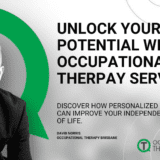Parkinson’s Disease Treatment: How You Can Delay The Decline
No matter what stage of life your at, the day of Parkinson’s Disease diagnosis often leaves people, maybe much like you, in a state of bewilderment. Getting a bearing on Parkinson’s Disease treatment can be confusing.
This is followed by emotions of fear and frustration then finally anger moving into a strong resolve and acceptance. Makes it sound straight forward, doesn’t it?
I don’t know where you’re at on your Parkinson’s Disease journey. It’s never a straight line but whilst you’re here, I thought to share with you about the exciting changes in Parkinson’s Disease treatment what they can offer you.
Maybe like you, for many years, I’ve been frustrated by the lack of Parkinson’s Disease treatment evidence which can help direct people to live better, move better and have a sense of control.
There has been very little PD treatment proof that there are solutions to effect real and meaningful change in your life. So that you can
- Get out of bed or chair
- Walk without fear
- Achieve active life goals
- Dance with your loved one
- Put a shirt on
- Go out for dinner to a crowded restaurant or bar
You no doubt appreciate my point, your PD symptoms can be a massive barrier to living a life you want.

It’s been a long wait but it’s clear there are Parkinson’s Disease treatments to help you combat the disease symptoms.
Parkinson’s Disease Treatment: Exercise as Medicine
Exercise can effect a change in the experience of the symptoms. Studies have shown that exercises is effective in
- Reducing stiffness
- Improving mobility
- Improving posture
- Improving balance
- Improving mood experiences such as depression.
However, Are All Exercises The Same for Parkinson’s Disease Treatment?
No is the short of it.
So, what do you need to look for in your Parkinson’s Disease exercise treatment regime?
It all starts with a thorough neurological and functional assessment. This is highly recommended occur with your preferred therapist. Out of this you’ll establish your goals and also strengths and challenges which need to be factored into your program.
Getting the right team around you is half the battle. With more control of your care be it through the NDIS or CDC in aged care programs, you’ve a lot more scope to include the therapist who best meets your needs
Now, about Parkinson’s Disease Treatment and Exercise.
Neuroplasticity, the capacity of the brain to change its self in response to its environment, is at the heart of your exercise efforts. Authors have described the role of exercise as neuro-protective, slowing the progression of change. I need to be clear, it’s not a cure, but it can impact your symptoms, positively.
When exercising there are 3 essential ingredients you need to be present for adaptive changes to occur in your brain. They are:
- Complexity: Activities/ exercise needs to be complex, challenging. I’d further add to this, it needs to be real, functional, related to life.
- Intensity: When you do an activity the level of intensity needs to be at a certain level of intensity in order to an adaptive response. Intensity may be measured in aerobic effort.
- Frequency: It needs to happen a lot and often.
Who is this Parkinson’s Disease Treatment for?
You’re never too late to start making positive changes to you and your ability to do what matters in your day to day life. That said, starting early is best. Early in your disease experience or immediately at time of diagnosis.
When should you start exercising?
Now.
What You Need
You don’t need a referral from your doctor but it can help you access government subsidies as well as helping all the people who support you be aware of who is doing what.
You need to have an attitude to commit, to roll up your sleeves to work hard. Your therapist will be there with you and it break our heart to see people fall short of their potential. We want to work with you if you’re committed to turn up, be present and put in. If you’re hungry for this type of therapy, want a therapy team who is centred on you and your goals, then we maybe right for each other.
What We Do With You
Your able to access
- Intense 4 week/ 4 days per week programs at your home. The LSVT BIG program is well evidenced. It’s intense, challenging and it happens often. This is not for the faint of heart. It’s a full tilt program for you and your therapist.
- PD PathFinder: Comprehensive action and treatment plans for the self directed. You do it, on your time, we catch up with you over the phone , online or face to face and help adjust the program for your goals. This is great for people out of Brisbane.
- Bootcamps with up to 8 other compadres. We do our level best to make this a fun, social, inspiring and hard session so you get the results for your goals.
We’ve very limited capacity to support 2 people only for each month with the 4 week intensives . Whilst other programs are offered on a regularly.
Of course, it always starts with a one on one assessment so you can get the right actions for your situation
Get Start Today
Simply
- Phone us at 1300 783 20 and our receptionist will take your details for a senior therapist to follow up with for a PD Exercise Program Enquiry Call. In this session we have a candid discussion about you, your goals and go over the therapy course and what it takes. Or you can request this at a click of a button by filling out the form below and our team will get back to you to schedule a phone call.
To your best- David
Schedule A Free PD Exercise Program Enquiry Call
Simply fill out the form below, and Meg, Karen or Nicki will arrange a time to speak with a senior OT. On this call the OT will see whether this program is a good fit for you and your goals.










